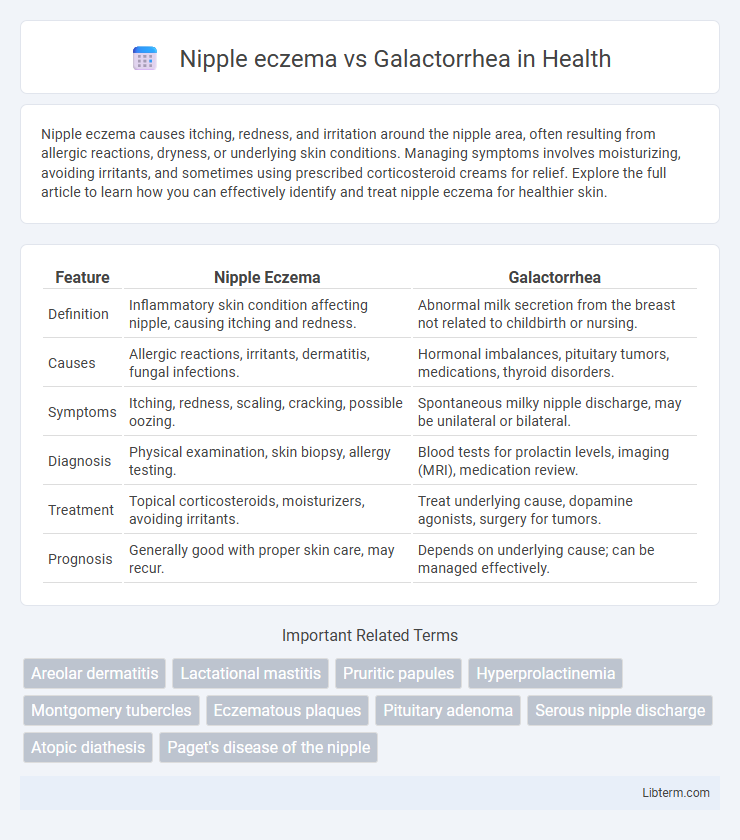Nipple eczema causes itching, redness, and irritation around the nipple area, often resulting from allergic reactions, dryness, or underlying skin conditions. Managing symptoms involves moisturizing, avoiding irritants, and sometimes using prescribed corticosteroid creams for relief. Explore the full article to learn how you can effectively identify and treat nipple eczema for healthier skin.
Table of Comparison
| Feature | Nipple Eczema | Galactorrhea |
|---|---|---|
| Definition | Inflammatory skin condition affecting nipple, causing itching and redness. | Abnormal milk secretion from the breast not related to childbirth or nursing. |
| Causes | Allergic reactions, irritants, dermatitis, fungal infections. | Hormonal imbalances, pituitary tumors, medications, thyroid disorders. |
| Symptoms | Itching, redness, scaling, cracking, possible oozing. | Spontaneous milky nipple discharge, may be unilateral or bilateral. |
| Diagnosis | Physical examination, skin biopsy, allergy testing. | Blood tests for prolactin levels, imaging (MRI), medication review. |
| Treatment | Topical corticosteroids, moisturizers, avoiding irritants. | Treat underlying cause, dopamine agonists, surgery for tumors. |
| Prognosis | Generally good with proper skin care, may recur. | Depends on underlying cause; can be managed effectively. |
Introduction to Nipple Eczema and Galactorrhea
Nipple eczema is a chronic inflammatory skin condition characterized by redness, itching, and scaling of the nipple and areola, often caused by allergic reactions, irritants, or underlying dermatological issues. Galactorrhea refers to the inappropriate or excessive production of milk from the breast, unrelated to childbirth or nursing, commonly linked to hormonal imbalances such as elevated prolactin levels. Differentiating between nipple eczema and galactorrhea involves careful clinical evaluation of symptoms, as nipple eczema primarily affects skin integrity while galactorrhea involves abnormal lactation.
Understanding Nipple Eczema: Causes and Risk Factors
Nipple eczema is a chronic inflammatory condition characterized by itching, redness, and scaling of the nipple and areola, often linked to atopic dermatitis or allergic reactions. Risk factors include a history of allergies, frequent irritation from breastfeeding, and exposure to harsh skin products. Unlike galactorrhea, which involves inappropriate milk discharge often caused by hormonal imbalances or medications, nipple eczema primarily affects skin integrity and requires targeted dermatological treatment.
Understanding Galactorrhea: Causes and Risk Factors
Galactorrhea is the abnormal production of breast milk unrelated to childbirth or nursing, often caused by hormonal imbalances such as elevated prolactin levels due to pituitary gland disorders or certain medications. Risk factors include hypothyroidism, chronic renal failure, use of antipsychotic drugs, and stress, which can disrupt normal endocrine function. Differentiating galactorrhea from nipple eczema, which is an inflammatory skin condition causing itching and scaling without milk production, is essential for accurate diagnosis and treatment.
Key Differences Between Nipple Eczema and Galactorrhea
Nipple eczema is a skin condition characterized by itching, redness, and flaky or crusted patches on the nipple, whereas galactorrhea involves the spontaneous flow of breast milk unrelated to childbirth or nursing. The primary symptom of nipple eczema is dermatological irritation, often caused by allergic reactions or irritants, while galactorrhea typically stems from hormonal imbalances, such as elevated prolactin levels. Treatment for nipple eczema focuses on topical corticosteroids and moisturizers, while managing galactorrhea requires addressing underlying endocrine disorders or medication adjustments.
Clinical Symptoms: How to Tell Them Apart
Nipple eczema presents with itching, redness, scaling, and sometimes oozing or crusting specifically on the nipple and areola, often accompanied by skin thickening or fissures. Galactorrhea is characterized by spontaneous, milky nipple discharge unrelated to breastfeeding, without significant skin changes or itching on the nipple surface. Distinguishing factors include the presence of eczematous skin lesions in nipple eczema versus the nipple discharge without dermatologic symptoms in galactorrhea.
Diagnosis: Tests for Nipple Eczema vs Galactorrhea
Diagnosis of nipple eczema primarily involves a clinical examination and skin biopsy to identify characteristic inflammation and rule out infections or malignancies. Galactorrhea diagnosis includes serum prolactin measurement, thyroid function tests, and imaging studies like MRI of the pituitary gland to detect hormonal imbalances or tumors. Differential diagnosis requires evaluating patient history, physical examination, and lab results to distinguish dermatologic from endocrine causes of nipple discharge.
Treatment Options for Nipple Eczema
Treatment options for nipple eczema primarily include the use of topical corticosteroids to reduce inflammation and alleviate itching, along with emollients that help restore the skin barrier. Avoidance of potential irritants, such as harsh detergents and synthetic fabrics, is crucial for preventing flare-ups. In contrast, galactorrhea treatment targets underlying hormonal imbalances or medication causes and involves dopamine agonists like bromocriptine rather than topical skin therapies.
Treatment Approaches for Galactorrhea
Treatment approaches for galactorrhea primarily involve addressing the underlying cause, often hyperprolactinemia, with dopamine agonists such as bromocriptine or cabergoline to normalize prolactin levels and reduce milk production. In cases linked to medication side effects or hypothyroidism, adjusting drug regimens or thyroid hormone replacement therapy can resolve symptoms effectively. Surgical intervention is reserved for pituitary tumors resistant to medical therapy, ensuring targeted management of galactorrhea without confusion with nipple eczema, which requires topical corticosteroids and moisturizers.
When to See a Doctor: Warning Signs
Persistent nipple eczema causing intense itching, cracking, or bleeding requires medical evaluation to rule out infections or underlying dermatological conditions like eczema or Paget's disease. Seek immediate medical attention for galactorrhea if nipple discharge is spontaneous, bloody, or accompanied by breast pain, swelling, or changes in skin texture, as these symptoms may indicate hormonal imbalances or serious breast disorders. Early consultation with a healthcare provider ensures accurate diagnosis, appropriate treatment, and exclusion of malignancies.
Prevention and Long-Term Management Strategies
Nipple eczema prevention involves maintaining skin hydration with emollients and avoiding irritants such as harsh soaps or fabrics, while long-term management includes regular dermatological evaluations and potential use of topical corticosteroids to reduce inflammation. Galactorrhea prevention hinges on identifying and managing underlying causes like hormonal imbalances or medication side effects, with long-term strategies emphasizing consistent endocrine monitoring, possible adjustments to offending medications, and addressing pituitary disorders through medical interventions. Both conditions benefit from patient education on symptom monitoring and lifestyle modifications to minimize recurrence and complications.
Nipple eczema Infographic

 libterm.com
libterm.com